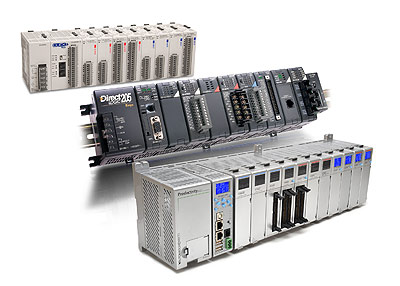Everyone knows there’s only one constant in the technology world and that’s change – inevitable change. This is highly evident in the evolution of PLCs and their varied applications. Let’s take a look at yesterday’s focus and more importantly, today’s and beyond. Preparing and equipping users to meet the challenges of technological change head-on is always a priority at AutomationDirect.
The most recent PLC Product Focus Study from Reed Research Group shows that not only are applications changing, but also the factors important to the users, machine builders and those making the purchasing decisions. Here’s a snapshot: 
• Process/batch control has now surpassed machine control as the most popular
application for micro-to-medium PLC applications (<512 I/O).
• Communications and processing skills of the micro PLC (15-128 I/O) continue to improve to the extent they exhibit the same capability in controlling process systems as their larger counterparts.
• Motion control and batch control continue to grow due to the increased flexibility of today’s PLCs and technology advancements that yield overall better performance.
The Greatest Change
Possibly the most significant change in the PLC market in recent years lies in the communications arena. Think about it. What single development has literally revolutionized the way PLCs are programmed, the way they talk to each other, and how they interface with PCs for HMI, SCADA or DCS applications? Not a tough question – in a word, the answer is Ethernet.
Use of Ethernet communications on the plant floor has basically doubled in the past five years. While serial communications remain popular and reliable, Ethernet is fast becoming the communications media of choice with advantages that simply can’t be ignored:
• Speed of the network
• Ease of use, i.e. setup and wiring
• Availability of off-the-shelf networking components
• Convenient “built-in-communications” setup
It’s not every day you can say you picked up a component for your industrial application at Wal-Mart or from a Web site that makes buying a snap. Ethernet communications modules are readily available with high-speed performance (10/100Mb) and flexible protocols. For example, AutomationDirect now offers Ethernet option modules for the DL05/06, DL205 and DL405 PLCs. These modules install easily in an option slot and allow peer networking among PLCs and PCs, for as little as $175 per node (10Mb H0-ECOM module for DL05/06). The 100Mb models provide support for TCP/IP, UDP/IP, IPX and MODBUS TCP/IP protocols.
Additionally, wireless communications is also gaining popularity, particularly in applications where distance and wiring expense make it a cost-effective alternative to wired systems. (For detailed articles on wireless communications, see the Winter 2005 issue of Automation Notebook or visit www.automationnotebook.com.) AutomationDirect’s Ethernet modules and serial port modules work well with the Cirronet line of serial and Ethernet radio modems that AutomationDirect now offers.
The Unchanged
Amidst continuous change, one facet of the PLC that remains true-to-form is the programming language. Approximately 95 percent of those surveyed still use ladder diagrams to construct their PLC code. Although many languages are now available, it seems that ladder logic still continues to be a top choice given it’s performed so well, for so long.
So what’s in store for the future? Let me consult the Magic 8-ball about this mystery, asking the question “Will there be change?” For once, I get a crystal clear answer: “WITHOUT A DOUBT.” So buckle up and hang on; it’s going to be a wild ride!
By Jeff Payne,
AutomationDirect Product Manager
PLC, I/O and PC-Controls Group
Originally Published: Sept. 1, 2005

